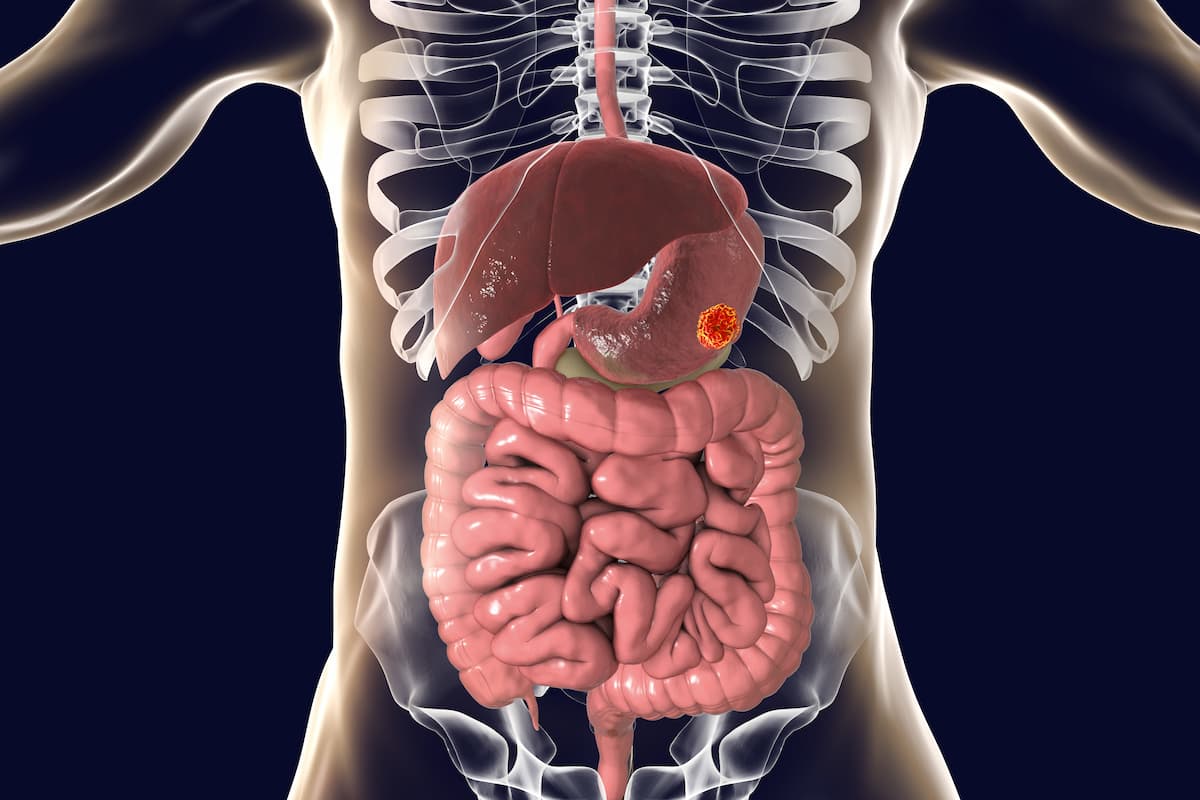Anti-TIGIT Combination Therapy Yields Positive Survival in Gastric Cancers
Survival results were similar among all patients and PD-L1 subgroups with the domvanalimab regimen in gastroesophageal junction adenocarcinoma.
Survival results were similar among all patients and PD-L1 subgroups with the domvanalimab regimen in gastroesophageal junction adenocarcinoma.

Results were announced from the phase 2 EDGE-Gastric trial (NCT05329766) evaluating domvanalimab plus zimberelimab and chemotherapy in patients with locally advanced unresectable or metastatic gastric, gastroesophageal junction, or esophageal adenocarcinoma in a press release from the developer, Arcus Biosciences.1
Domvanalimab is an Fc-silent anti-TIGIT antibody, and zimberelimab is an anti–PD-1 monoclonal antibody.
The data cutoff was March 3, 2025, the median follow-up was 26.4 months, and the median time on treatment was 49 weeks.
In all patients enrolled in arm A1 of the trial, the median overall survival (OS) was 26.7 months (90% CI, 18.4-not estimable [NE]), with a 24-month OS rate of 50.2% (90% CI, 36.3%-62.6%). The median progression-free survival (PFS) was 12.9 months (90% CI, 9.8-14.6), with a 24-month PFS rate of 25.9% (90% CI, 14.8%-38.5%). Additionally, the confirmed overall response rate (ORR) was 59% (90% CI, 45%-72%).
In patients who had PD-L1–positive disease, defined as having a tumor area positivity of 1% or greater, the median OS was 26.7 months (90% CI, 19.5-NE), with a 24-month OS rate of 53.8% (90% CI, 37.3%-67.7%). The median PFS was 13.2 months (90% CI, 11.3-15.2), with a 24-month PFS rate of 24.9% (90% CI, 12.1%-39.9%). The confirmed ORR was 62% (90% CI, 45%-77%).
In patients who had PD-L1–high disease, defined as having a tumor area positivity of 5% or higher, the median OS was NE (90% CI, 17.4-NE), with a 24-month OS rate of 56.3% (90% CI, 33.9%-73.6%). The median PFS was 14.5 months (90% CI, 11.3-NE), with a 24-month PFS rate of 31.3% (90% CI, 14.0%-50.2%). The confirmed ORR was 69% (90% CI, 45%-87%).
These data will be shared in a mini oral session at the European Society for Medical Oncology 2025 Congress.
“It is impressive to see that 50% of the patients enrolled in arm A1 of the EDGE-Gastric study went on to live for more than 2 years,” stated Sun Young Rha, MD, PhD, professor of medical oncology in the Department of Internal Medicine and the director of Songdang Institute for Cancer Research at Yonsei University College of Medicine at Yonsei University Health System in Seoul, South Korea, in the press release.1 “A 26.7-month median [OS] is well beyond what would be required to demonstrate clinically meaningful benefit over standard of care.”
EDGE-Gastric was a phase 2 trial that evaluated the safety and efficacy of various combination therapies in patients with advanced upper gastrointestinal tract malignancies.2 The trial had an estimated enrollment of 332 patients; these results included data from 41 patients included in arm A1 of the trial.
Treatment in arm A1 consisted of 1600 mg of intravenous domvanalimab every 4 weeks, 480 mg of intravenous zimberelimab every 4 weeks, and FOLFOX chemotherapy—intravenous oxaliplatin at 85 mg/m2, intravenous leucovorin at 400 mg/m2, and intravenous bolus fluorouracil at 400 mg/m2 plus 2400 mg/m2 continuously over a 46- to 48-hour infusion—every 2 weeks.
Arm A1 enrolled those with previously untreated gastric, gastroesophageal, and esophageal adenocarcinoma. Additional enrollment criteria included an ECOG performance status of 0 or 1, at least 1 measurable lesion per RECIST v1.1 guidelines, and adequate organ and marrow function.
Exclusion criteria included underlying medical conditions that would have made the administration of investigational products hazardous; known untreated, symptomatic, or actively progressing central nervous system metastases; and discontinued use of prior immune checkpoint therapy due to immune-related adverse events (AEs).
The primary end point of the trial was the number of patients with AEs and the ORR per RECIST v1.1 criteria. Secondary end points included OS, PFS, disease control for 12 weeks or more, duration of response, and ORR measured by PD-L1 expression level.
Regarding safety, no unexpected safety signals were observed as of the data cutoff. Immune-mediated treatment-emergent AEs related to domvanalimab and/or zimberelimab occurred in 22% of patients, and infusion-related reactions occurred in 7%.
References
- Anti-TIGIT domvanalimab plus anti-PD-1 zimberelimab and chemotherapy showed 26.7 months of median overall survival as first-line treatment of unresectable or advanced gastroesophageal adenocarcinomas in the phase 2 EDGE-Gastric study. News release. Arcus Biosciences. October 12, 2025. Accessed October 13, 2025. https://tinyurl.com/2renbzja
- A safety and efficacy study of treatment combinations with and without chemotherapy in adult participants with advanced upper gastrointestinal tract malignancies (EDGE-Gastric). ClinicalTrials.gov. Updated September 29, 2025. Accessed October 13, 2025. https://tinyurl.com/bdbnnpy2